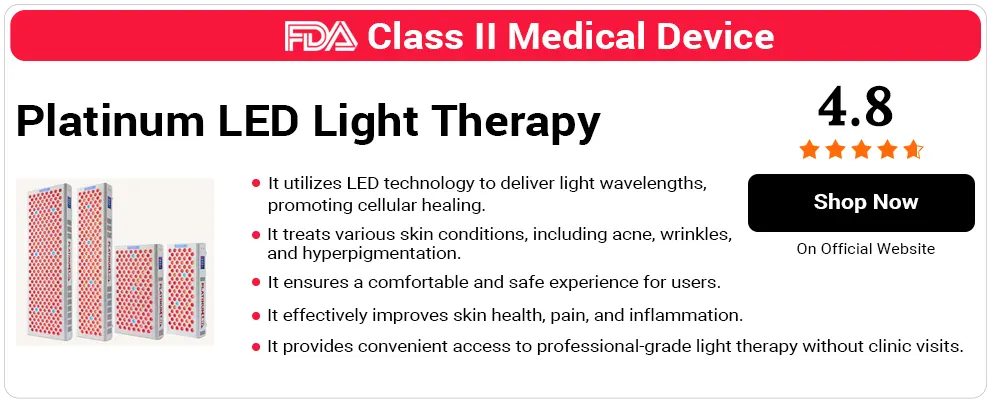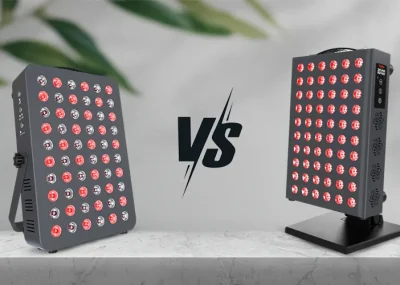They say there are many ways to kill a cat, and so is taking care of your health. Other than eating healthy, staying active, sleeping well, and drinking enough water, you can also utilize the power of light therapy to enhance and support your health.
Light therapy is an easy way to optimize your health, convenient and relatively cheap. You can also use light therapy with proper guidance in the comfort of your home. Thus saving you both time and money that you’d have otherwise used in a light therapy clinic.
Today, we want to focus more on uncovering the light therapy of 810 Nanometer Wavelength. We’ll be covering all that you need to know from benefits, and how it works to side effects.
According to a 2022 article highlights,
The 810nm LED is the most commonly used light source in the field of PBM
What Are The Health Benefits Of 810 Nanometer Wavelength
Light therapy has various health benefits depending on the type of light emitted, intensity, and wavelength. 810 Nanometer Wavelength falls under the red and near-infrared light bracket. It’s known as a visible and highly penetrative light wavelength that supports quick healing and recovery amongst other benefits. Let’s have a look at them down below:
- It helps in improving brain health and memory. According to a compilation of multiple studies individuals who are exposed to light therapy of 810 nm wavelengths do show improvement concerning brain health and memory.
- Low light laser therapy has been used severally in treating and improving carpal tunnel syndrome because the wavelengths have a better deeper penetration to the skin and wrist tissues. It is also mainly considered effective and efficient because it offers a non-surgical option that’s painless and efficient.
- Low light therapy at 810nm wavelength is known for its immersive benefits to the skin such as reducing visible signs of aging and minimizing skin inflammation and other dermatitis symptoms.
According to a study, low light at 810nm deeply penetrates the skin effectively lowering the risk of skin cancer, and photoaging and minimizing hyperpigmentation from sun exposure.
This technology is so great because it is completely painless and doesn’t cause damage to the skin or downtime, like some other light therapies do,” says Dr. Engelman. “RLT induces skin regeneration, whereas other therapies stimulate tissue repair by causing controlled damage to the outermost layer of the skin. This is why RLT has huge benefits of reducing wrinkles, scars, and acne.
- Photobiomodulation therapy with an 810nm wavelength is associated with improving physical performance during exercise through increasing energy levels and decreasing muscle fatigue. It’s linked to better quick recovery after workouts by decreasing inflammation, and oxidative stress.
- There’s enough evidence that shows laser light therapy at 810nm wavelength is ideal for lowering overall body pain, and back pain and helps in recovery after surgeries. Therefore, it’s suitable for individuals struggling with lower back and muscle pain. It also improves the functionality of areas affected by pain.
How Does 810 Nanometer Wavelength Work?
NIR 810nm wavelengths are found to be beneficial. They have the most profound effect because they generate negligible and effective amounts of heat. The skin responds more positively to near-infrared low light than other body organs.
810nm wavelength works by stimulating the mitochondria, increasing ATP levels which in return increase blood flow and activate signaling pathways. Therefore, this process triggers the activation of stem cells and improves various biological responses. Thus enhancing the repair of tissues, increasing recovery speed, and improving overall health.
What Does Scientific Research Say About 810 Nanometer Wavelength?
Several scientific research show enough evidence that 810nm wavelength is beneficial to human health and improves various conditions at a cheaper price. Here are some of them;
- One study showed that photobiomodulation at 810nm enhances exercise performance and improves recovery after workouts by improving biomarkers associated with muscle damage and inflammation.
Low wavelength red light produces a biochemical effect in cells to make more energy, which in turn helps cells work more efficiently to rejuvenate and repair damage,
says Dendy Engelman, MD, FACMS, FAAD, a board-certified cosmetic dermatologist at Shafer Clinic in New York City.
- This research shows that laser light at 810nm proved to be effective in managing pain in a group of individuals who had severe back pain from a degenerative condition.
By increasing blood circulation and stimulating the body’s healing processes, RLT helps reduce pain from arthritis,
says Dendy Engelman, MD, FACMS, FAAD, a board-certified cosmetic dermatologist at Shafer Clinic in New York City.
- A 2015 study documents the outcome of low light therapy at 810nm wavelength in conservative treatment of chronic back pain. The trial results show that it’s 90% effective in elevating pain both for short-term and long-term use.
- A trial of 32 individual cases who had undergone coronary artery bypass grafting surgery was observed to investigate the effect of low laser light therapy of 810nm wavelength on tissue healing. Results showed that helped in the recovery and repair of cardiac tissues.
Who Should Use 810 Nanometer Wavelength?
What we are finding now is that light can and should be prescribed like any pharmaceutical—we refer to it as ‘photoceutical,’ says Dr. Eells. Each and every condition has a different prescribed treatment designed to achieve a specific outcome.
Anyone can use red and laser therapy lights that emit 810nm wavelength for various conditions. The wavelength is considered to be safe and doesn’t cause any health risks. However, if you’re pregnant, or have underlying health issues that you’re not sure of whether or not to use light therapy at 810nm wavelength, it is better to seek professional advice.
It’s always best to have another set of eyes whenever you’re adding something new into your wellness regimen,
says Dr. Kelley, M.D., founder and medical director of Case Integrative Health. Once you get a second opinion from a professional then you can go ahead with confidence.
What Side Effects Should You Expect?
Light therapy at 810 nanometer wavelength is generally considered to be safe and effective. However, if used for long hours, it may cause skin irritation to individuals with sensitive skin just like any other type of exposure to light.
There’s also speculation that the 810-nanometer wavelength may cause fatigue, affect muscle endurance, and accelerate or worsen the degree of existing neurodegenerative conditions.
Light experts also prefer that you use FDA-cleared devices at the right dosage and FDA-approved masks to ensure your protection and prevent injury or any adverse side effects.
Frequently Asked Questions
Where Can I Buy Red Light And Near-Infrared Devices With 810 Nanometer Wavelength Devices?
A: You can purchase such devices either on Amazon or on official light therapy brand sites.
Are Light Therapy Devices With 810-Nanometer Wavelength Worth It?
A: According to research and customer feedback from various brands that sell these devices, they are worth it provided you get the right device for your condition.
How Do You Use 810 Nanometer Wavelength Devices?
A: Each device has different instructions for use according to the manufacturer’s guide. Therefore, you’d have to read the guide before use. If you have any doubts, you can also use a similar light therapy device in a clinic near you under professional guidance.
How Much Does An 810 Nanometer Wavelength Device Cost?
A: The cost per device varies from one brand to the other. Also, your budget will influence the quality and the type of light device to get.
How Many Times Should You Use Light Therapy?
A: Your frequency of use will depend on the condition you’re treating, professional guidance or the manufacturer’s instruction.
When Can I Expect To See Results Once I Start Using 810nm Wavelength?
A: Results vary from person to person depending on different factors such as purpose of use and frequency of use. For quick results, it’s advisable to stay consistent and use a light therapy device as directed by the manufacturer or a light therapy specialist.
Conclusion
Light therapy is a convenient way of treating and managing any condition at home. You can treat back pain, relieve muscle fatigue, eliminate signs of aging, and improve skin condition with the use of light devices. Therefore, it’s important to not only find the right light therapy device but also know which wavelength to use for your conditions.
Read the instructions, and don’t overpush your at-home device thinking that if you use it more or longer than the recommended time it will lead to better results, says Dr. Kung. Bottom-line is red light units at home are a no-harm no-foul type of thing, but, be realistic—a $200 device on Amazon can’t deliver wow-factor results like an $180,000 laser.
Our article has captured all that you need to know concerning 810 nm wavelength and the health benefits associated with it. We’ve also gone a step further to capture what scientific research says about 810 nm wavelength revealing the good, bad, and ugly. In doing so, we hope that you’ve found it insightful and feel confident enough to navigate the world of low-light therapy with ease.









